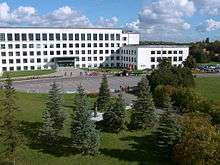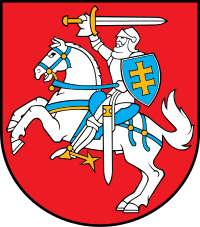Agriculture in Lithuania
Agriculture in Lithuania dates to the Neolithic period, about 3,000 to 1,000 BC. It has been one of Lithuania's most important occupations for many centuries.
History

As elsewhere, the practice of agriculture in Lithuania during the Neolithic period showed limited scope and was constrained by the availability of tools. There is evidence that its early practitioners employed slash and burn techniques to clear their fields. The use of domestic animals, first seen during the Bronze Age, had become widespread during the Iron Age.
Wheat cultivation in the area has been dated to the 1st century BC; the first evidence of widespread cultivation of rye has been dated to the 1st century AD. Barley probably appeared in the 2nd century BC, while potatoes did not gain popularity until the late 18th century. These crops remain major contributors to the agricultural sector.
Although Lithuania experienced major famines in 1719-1724, 1850, and 1867–68, the country was usually able to sustain itself, and exported much of its output.
The role of the agriculture in independent Lithuania has remained relatively significant throughout the entire Interbellum. After the land reform launched in 1922, which provided 65,000 people with agricultural land, the number of landowners has risen significantly. The establishment of the Academy of Agriculture in Dotnuva in 1924 has contributed significantly to the quality of land exploitation and the high social status of agronomists. The agricultural products have taken a large share in the total export of Lithuania until the 1940s, which contributes to a naming of Interbellum Lithuania an agricultural state.
Lithuanian agriculture was collectivized during the early years of Soviet rule; although as a general rule, this system was unproductive, it became relatively efficient in the late 1950s when Moscow granted the communist leadership in Vilnius greater control of agricultural policy. Lithuanian farm workers were 50% more productive than the Soviet average but much less productive than their Western counterparts. As in other Soviet-dominated areas, about one-third of agricultural production came from private plots of land and not from collective or state farms. Nevertheless, Lithuanian agricultural production was high enough to allow the export of about 50% of total output.
The agricultural sector contributed 24% of GDP in 1992 and employed 19% of the labor force. Lithuania's agriculture, efficient by Soviet standards, was producing a huge surplus that could not be consumed domestically. In 1992, about 48% of the arable land was used for grain, 41% for forage crops, 5% for potatoes, and 3% for flax and sugar beets. Crops accounted for one-third and livestock for two-thirds of the total value of agricultural output.
Significant reforms were introduced in the early 1990s to reestablish private ownership and management in the agricultural sector. Although Lithuania succeeded in privatizing more agricultural land than Estonia or Latvia, agricultural production decreased by more than 50 percent from 1989 to 1994. One problem was that farms were broken up into smallholdings, averaging 8.8 hectares in size, often not large enough to be economically viable. A serious drought in 1994 further reduced agricultural output and cost farmers an estimated 790 million litas in production.
Current operations
As of 2004, the agricultural sector in Lithuania employed about 227,000 persons; contributed about 6% of its GDP; and occupied about 35,000 km2, of which about 9,000 km2 were abandoned.[1] In 2001 the principal crops were potatoes, 1,054,000 tons; barley, 776,200 tons; wheat, 1,076,300 tons; rye, 231,100 tons; legumes, 52,200 tons, and rapeseed, 64,800 tons.[2] About 46% of its land area was devoted to crops and pastures.
Lithuania's accession to the European Union in 2004 ushered in a new agricultural era. The EU pursues a very high standard of food safety and purity. In 1999, the Seimas (parliament) of Lithuania adopted a Law on Product Safety, and in 2000 it adopted a Law on Food. The reform of the agricultural market has been carried out on the basis of these two laws.
According to a 2006 USDA report, organic farming in Lithuania is expanding rapidly and could account for up to 15 percent of farm area by 2015.[3] In 2005 there were about 1,807 farms certified as organic in Lithuania, with an average size of 0.39 km2. In 2004 organic certified land area covered 430 km2 of farmed area and by 2005 organic farm area had increased to 703.89 km2, or about 1.5 percent of total farm area.
The average Lithuanian organic farm size, 0.39 km2, is about four times the size of the average conventional farm. The largest organic farm is 7 km2. Grass and leguminous crops accounted for 61% of total organic farming in 2005, followed by perennial grasses at 26%. The most significant increase in organic farming has been in berry production. Financial support for organic farming is offered by the EU.
Agricultural research institutions

- The Lithuanian Ministry of Agriculture
- Lithuanian University of Agriculture
- Lithuanian Veterinary Academy
- Lithuanian Institute of Agrarian Economics
- (in Lithuanian) Lithuanian Institute of Agriculture
See also
References
General
In-Line
- The Lithuanian Agricultural Sector Archived February 21, 2007, at the Wayback Machine
- Crop production in 2001
- Organic Farming in Lithuania
External links
- Valstiečių laikraštis (in Lithuanian) (based in Lithuania)
